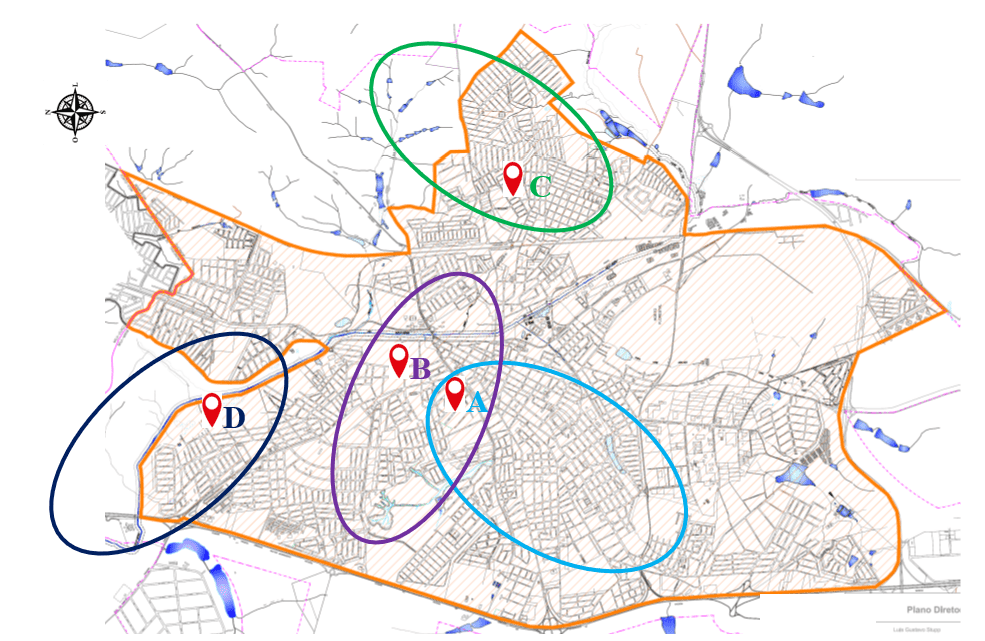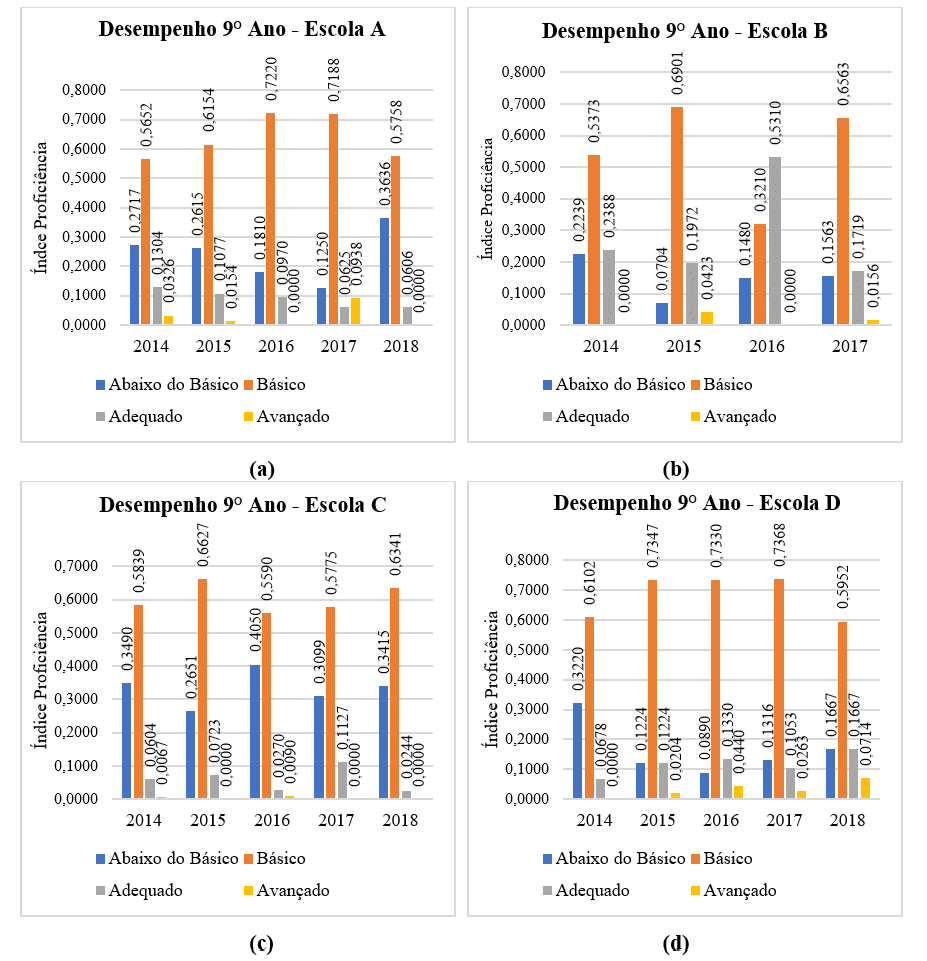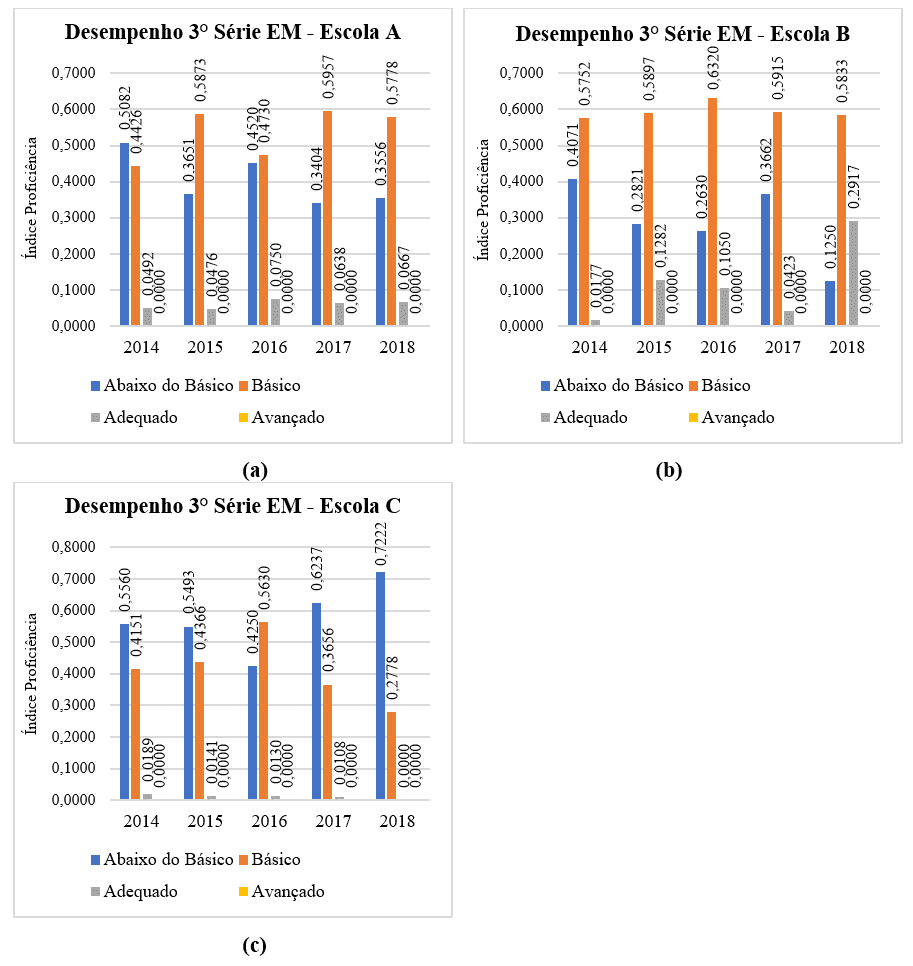ORIGINAL ARTICLE
CAMPOS, Marco Antonio [1]
CAMPOS, Marco Antonio. Performance levels in mathematics of State Schools of the Municipality of Mogi Mirim – SP. Revista Científica Multidisciplinar Núcleo do Conhecimento. Year 05, Ed. 11, Vol. 03, pp. 79-90. November 2020. ISSN: 2448-0959, Access link: https://www.nucleodoconhecimento.com.br/education/state-schools
ABSTRACT
The performance in the mathematics course of students from public schools in the state of São Paulo is measured by evaluating the Saresp applied at the end of each school cycle. This classifies the students into four performance levels “Below basic”, “Basic” “Adequate” and “Advanced” according to criteria and scores stipulated by the state department of education in São Paulo. Based on the publication of these performance levels, four state schools in the municipality of Mogi Mirim-SP, belonging to the Mogi Mirim Teaching Board, between 2014 and 2018 were analyzed in the discipline of Mathematics in the 9th year of elementary school and in the 3rd grade of high school. The results show that learning falls short of what is desired for students who are ending a school cycle. Therefore, together with the analysis of these results, questions and potentialities of these factors compromising learning in relation to management, faculty and students and the school community are presented.
Keywords: School performance, Saresp, educational performance, public education, mathematics.
1. INTRODUCTION
Public education in the state of São Paulo has its results based on performance indexes standardized by the State Department of Education, current Seduc-SP. Currently the subjects of Portuguese Language and Mathematics receive at least four performance evaluations, for all years of Elementary and High School: ADE – Diagnostic Evaluation of Entry, applied in the first weeks of class, with the content of the previous year, and at the end of the 1st, 2nd and 3rd bimasters are applied the AAP: Evaluation of Learning in Process , with the content of the Didactic Sequences of the curriculum of these disciplines.
These evaluations, ADE and AAP, are evaluations prepared by Seduc-SP and standardized and equal for the entire network. For example, all students of the 9th year of elementary school take, in a period determined by Seduc-SP, the same AAP test of the 1st bimester of Mathematics.
The application of these evaluations, in addition to verifying the development of the class and identifying potential teaching/learning failures along the route, becomes a greater training for other external evaluations and especially for the Saresp – School Performance Assessment System of the State of São Paulo, annual evaluation applied at the end of each cycle, 5th and 9th Years of Elementary School and 3rd Grade of High School.
With the Saresp score, students have their performance classified into four levels of proficiency defined based on the learning expectations of the Pedagogical Proposal of the State of São Paulo. (São Paulo, 2010)
Table 1 presents the description and reference values of the performance levels of these proficiency in mathematics. It is noteworthy that these levels of proficiency are valid for elementary and high school.
Table 1. Description Saresp performance levels.
| Performance Levels | Description | Reference values | |
| 9th Grade Elementary School | 3rd Grade High School | ||
| Below the basics | They demonstrate insufficient mastery of the contents, skills and skills required for the school grade in which they are | < 225 | < 275 |
| Basic | Demonstrate partial development of the contents, skills and skills required for the school grade in which they are | Between 225 and 300 | Between 275 and 350 |
| Adequate | Demonstrate knowledge and mastery of the contents, skills and skills required for the school grade in which they are | Between 300 and 350 | Between 350 and 400 |
| Advanced | They demonstrate knowledge and mastery of the contents, skills and skills beyond those required for the school grade in which they are | > 350 | > 400 |
Source: Adapted São Paulo, 2010.
The result of Saresp is the basis for the calculation of Idesp, an indicator created in 2007 to measure the quality of education in the state network of São Paulo, which is an index that considers the results of the Saresp and the school flow, which is composed of the approval, disapproval and dropout rates of students in the school unit. (SÃO PAULO, 2020 (a))
The public disclosure of Idesp indices and indicators of Proficiency levels of Saresp is a way to hold all those involved in the performance of students accountable, arouse interest in contributing and potentially create forms and incentives to improve performance, with government actions, greater participation of parents and the school community. (VELOSO, 2009; OSHIRO; SCORZAFAVE, 2011)
Through these educational indices, education has become a measurable variable where statistical indicators allow the often mistaken conclusion that a higher index reflects educational success. It is necessary to apply to the concept of educational quality, not only a numerical value, but also the ideological, political and social factors to which the entire school community is inserted. (UNESCO, 2007; GESQUI, 2014)
Without this premise of contextualizing the school community, the public dissemination of the results of external and standardized evaluations for the entire network works as a way to hold schools and their employees accountable for the performance of students and, thus, create incentives for improvement. This presupposes a greater participation of parents to improve results and also the offer of awards or “punitive sanctions” in view of performance in exams (VELOSO, 2009).
The pressure to improve performance levels on teachers is greater from management (teaching supervisor, principal, deputy director and coordinator) and in a small portion by parents who hold teachers accountable for their children’s success. When analyzing the school, students and teachers, some faculty members blame the teachers of the subjects of Mathematics and Portuguese language for the low performance. Some students, on the other, directly blame teachers for their personal results. (GESQUI, 2014)
Thus, the teachers of Mathematics and Portuguese Language, which are the disciplines analyzed in Saresp, are the main actors when having their functions and performance analyzed and judged by their superiors, peers and the school community. The entire management team and faculty are more concerned with the repercussion of the dissemination of the results of proficiency levels than with the good pedagogical practices applied throughout the learning process. (GESQUI, 2014)
In these conditions new actions and interventions are carried out each year so that schools improve the performance of their students. The implementation of The ADE and AAP assessments are examples of these actions aimed at the success of the entire network, as well as some training to the faculty of the disciplines of Saresp and provision of support material, student notebook handout, standardized for the entire network.
Therefore, the general objective of this work is to analyze the levels of proficiency in mathematics, in the period between 2014 and 2018, of four state schools in the municipality of Mogi Mirim, in the 9th year of elementary school and in the 3rd grade of high school, contextualizing this performance with issues related to the location of the school, management team , faculty and student and participation of the school community in the school routine.
2. DEVELOPMENT
This research was based on the analysis of the level of performance and proficiency in the discipline of Mathematics obtained in the evaluation of Saresp, in four state schools in the municipality of Mogi Mirim, in the state of São Paulo, members of the Board of Education of the Region of Mogi Mirim – DE Mogi Mirim.
Figure 1 shows the location of these schools and the range of students, with School A concentrating more students from the South and West Zones, as well as many students from the rural area and being located in the central region of the city ends up receiving students from all over the city.
School B has a predominance of students from the Central region and the beginning of the peripheral areas. Schools C and D are schools on the outskirts of Mogi Mirim, locating In the East Zone School C and in the North Zone School D
Figure 1. Average location radius of the students’ residence in the schools analyzed.

Figure 2 shows the illustration of performance in mathematics for the 9th grade of elementary school, figure 2 (a), School A, School B Figure 2 (b), Figure 2 (c) School C and School D Figure 2 (d).
Figure 2. Performance in Mathematics, 9th Grade Elementary School, School A (a), School B (b), School C (c), School D (d).

It is observed in all the schools analyzed that the majority of students have their performance in Mathematics classified in the level of proficiency “Basic”, that is, in the evaluations of Saresp, in the period between 2014 and 2018, the students demonstrated partial development of the contents, skills and skills required for the school grade in which they are.
Generally speaking, performance is small at the “Adequate” or “Advanced” levels. The highest percentage of students in School A have “Below Basic” and “Basic” performance levels, indicating that students have not fully developed the contents, competencies, and skills for the evaluated school period.
School B showed nonlinear variation between performance levels, however, it is the school with the highest number of students at the “Adequate” level, that is, some of its students demonstrate knowledge and mastery of the contents, skills and skills required for the school grade in which they are.
With a higher percentage of proficiency at the “Below basic” level, school C students demonstrate insufficient mastery of the contents, skills and skills required for the school grade in which they are.
In school D, even being a school of the Integral Education Program – PEI, the largest number of students have a “Basic” level of proficiency in Mathematics, that is, their students demonstrate partial development of the contents, skills and skills required for the school grade in which they are, a fact that does not meet the characteristics of the PEI school, which tends to have a more efficient teaching than the schools that are not part of this program.
The performance in Mathematics for the 3rd Grade of High School of School A is presented in Figure 3 (a), of School B in Figure 3 (b) and In Figure 3 (c) the performance of School C is performed. D-School doesn’t offer high school.
Unlike the performance in the 9th grade of elementary school, School A, in the 3rd grade of high school, has a large portion of its students with knowledge in Mathematics classified as “Below the basics”, that is, they demonstrate insufficient mastery of the contents, skills and skills required for the school grade in which they are. However, in the last two years analyzed, 2017 and 2018, the number of students with “Basic” knowledge increased.
School B has the largest share of its students in the 3rd grade of high school with knowledge “Basic” in Mathematics indicating partial development of the contents, skills and skills required for the school grade in which they are. For the year 2018, the school started to operate in the PEI modality, a factor that contributed to the increase of students with “Adequate” knowledge, that is, students demonstrate knowledge and mastery of the contents, skills and skills required for the school grade in which they are.
School C, again, is the one that has the worst performance in mathematics, and most of its students in the 3rd grade of high school have knowledge “Below the basics”, that is, they demonstrate insufficient mastery of the contents, skills and skills required for the school grade in which they are. D-School does not offer the high school modality.
Figure 3. Performance in Mathematics, 3rd Grade High School, School A (a), School B (b), School C (c).

One fact to be highlighted in all schools analyzed in the 3rd Grade of High School is the lack of students with “Advanced” knowledge in Mathematics, that is, no student from the three schools analyzed from 2014 to 2018 demonstrate stake and mastery of the contents, competencies and skills beyond those required for the school grade in which they are, which indicates a potential knowledge gap not only for the evaluation itself, but for the continuity of their studies at the technical and/or higher levels.
It is public knowledge that high school students have higher learning lags compared to elementary school performance, in addition to higher rates of dropout and dropout.
Allied to these factors, high school is often offered in the morning, with five weekly math classes, and at night, with four weekly classes. This has a 20% difference in the workload for the same grade, which can already compromise teaching and often discourage the student to study more and achieve better levels of performance in the evaluations.
Because it is offered in two distinct shifts, high school has higher turnover of students between periods, due to the search for professional qualification and employment, also contributing to the increase in the rates of dropout and dropout.
Many state schools face issues related to the constant changes of the school’s management team, not following the actions of previous administrations, with each in a short time of service wanting to print their brand, but without analyzing and continuing what was resulting.
In addition, the high turnover of the teaching staff is added, due to the lack of effective teachers and the public policies for hiring temporary teachers. On the other hand, the student body of state schools is marked by students with different socio-economic levels, from those with potential conditions of social vulnerability to middle-class families.
Therefore, the sum of all these factors compromises the quality of teaching of state schools in São Paulo, reflecting the performance in Mathematics verified in the Saresp evaluations. Thus, the performance improvement is not restricted to the commitment of students during the studies and achievements of evaluations, social actions are necessary for the entire school community, management team and stable faculty and support of Seduc-SP to conduct their work so that this situation reverts, that is, we have more students with “Adequate” and “Advanced” performance level in mathematics discipline , for the 9th Year of Elementary School and 3rd Grade of High School.
3. CONCLUSION
An initial analysis of the levels of performance in the discipline of Mathematics, in public schools in the state of São Paulo, allows to attribute, in the initial, the low levels of performance the lack of control in the actions and goals by the management team, accompanied by lack of commitment of the faculty and commitment of the students.
However, several factors that influenced these low levels of performance in mathematics for the 9th grade of elementary school and for the 3rd grade of high school must be considered, not only for the schools analyzed, but in the context of the state level. Teachers cannot simply be held responsible and school management for pupils’ performance, a macro explanation is needed to verify the reasons for these results.
Based on previous studies it is possible to add some considerations related to these factors. The state public school of São Paulo is currently a place to keep students for at least 75% of the school year and that they carry out external evaluations when requested.
These factors are combined with the potential apathy of a small portion of managers and teachers in applying new methods, techniques and procedures that result in an effective teaching and learning process in the face of simple training and “training” to perform these assessments, AAP, ADE and Saresp, for example. (GESQUI, 2014)
Such apathy is linked to the case, at the national level with public basic education, reflecting in low renumbering to professionals, impossibility of managers to select their teaching staff and, mainly, students, because the enrollment system is strictly geographical, that is, the student has to be enrolled in the school closer to his home. And there is no mechanism or legislation that prevents a public school from accepting or refusing a student.
The location of the school and its student body entails greater exchange of teachers and management in peripheral schools and with consequent lower levels of performance in evaluations such as Saresp, leaving those with more service time better classified and therefore having preference, both at the time of removal, for the staff, as at the time of the choice of classes for the non-effective.
With this, the turnover of teachers among the state schools of São Paulo is high, with teachers with less experience in teaching in more peripheral schools, which have, for the most part, lower levels of performance, as can be verified in this analysis with the results of School C.
The very lack of autonomy of the class assignment team at the regional level, The Board of Education, and the management in accepting or refusing a teacher is already a factor so that education does not function as a management structure that can be correct by unforeseen and poor results. (TAVARES, 2012)
However, the stable and experienced staff is not a guarantee of better results. These teachers encourage and know how to get around unforeseen events, work with adversities and mainly know the types of tests analyzed, but there is a need for greater commitment of students throughout the school year and greater engagement and responsibility in the achievements of evaluations.
Considering the application of standardized evaluations by Seduc-SP, ADE, AAP and Saresp, public education in São Paulo is increasingly punctuated in standardized numerical indices, in the case of performance levels in Mathematics analyzed in this study. These indexes allow us to guide educational actions and plans, pressuring professionals to meet goals, however, in many cases these results are not considered by management and teachers in conducting their work, which could result in improved learning of students. (GESQUI, 2014)
Analyzing the levels of performance in the discipline of Mathematics, based on the results of the evaluation of Saresp, in the period from 2014 to 2018 in four state schools in the municipality of Mogi Mirim, Mogi Mirim Teaching Board, in elementary schools final years (9th grade) and 3rd grade of high school, the results illustrate a low level of proficiency of students.
The vast majority of 9th grade students present “Basic” performance in mathematics, that is, students demonstrate partial development of the contents, skills and skills required for the school grade in which they are.
For the 3rd Grade of High School the performance level “Below basics”, which is one in which students demonstrate insufficient mastery of the contents, skills and skills required for the school grade in which they are, reached a considerable portion of the student, which demonstrates that the learning of these students is not being adequate for their basic school education and continuation of studies.
Therefore, the levels of performance in Mathematics, not only analyzed here throughout the public network of São Paulo, show that Seduc-SP needs to develop actions to improve learning, with management team and faculty comriding these methodologies and adapting them to the reality of the location of the school unit and especially that there is greater commitment of students and school community , to reverse these levels of performance, having more and more students at “Adequate” and “Advanced” levels, which will be the result of a quality public education, which is what everyone involved craves.
4. REFERENCES
GESQUI, L. C. A gestão escolar refém dos resultados das avaliações externas em larga escala. Revista de Ciências Humanas – Educação, Frederico Westphalen-RS. v. 15, n. 25, Dez. 2014
MOGI MIRIM. Revisão do Plano Diretor de Mogi Mirim. 2015. Disponível em: https://consulta.siscam.com.br/camaramogimirim/Documentos/Documento/36705. Acesso em: 27/04/2020.
OSHIRO, C. H.; SCORZAFAVE, L. G. Efeito do pagamento de bônus aos professores sobre a proficiência escolar no estado de São Paulo. Encontro Anpec – 2011. Disponível em: https://www.anpec.org.br/encontro/2011/inscricao/arquivos/000-e95d077296d03faa27e429dc66192da8.pdf. Acesso em: 24/04/2020.
SÃO PAULO. Programa de Qualidade da Escola – Sumário Executivo – Março/2010. Disponível em: http://idesp.edunet.sp.gov.br/Arquivos/Nota_tecnica_2009.pdf. Acesso em: 21/04/2020.
SÃO PAULO. Idesp 2019 mostra evolução dos alunos do Ensino Fundamental da rede paulista. Disponível em: https://www.saopaulo.sp.gov.br/spnoticias/idesp-2019-mostra-evolucao-dos-alunos-do-ensino-fundamental-da-rede-estadual-de-sp/. Acesso em: 21/04/2020. (a)
SÃO PAULO. Índices Idesp. Disponível em: http://idesp.edunet.sp.gov.br/. Aceso em: 30/04/2020. (b)
TAVARES, P. A. Os impactos de práticas de gestão escolar sobre o desempenho educacional: evidências para escolas estaduais paulistas. In: Textos para Discussão da Escola de Economia de São Paulo da Fundação Getulio Vargas – FGV-EESP. Julho, 2012.
UNESCO. Educação de qualidade para todos: um assunto de direitos humanos. Brasília: Unesco Orelac. 2007.138p.
VELOSO, F. Experiências de Reforma Educacional nas Últimas Duas Décadas: o que Podemos Aprender?. In: VELOSO, F. (Org), Educação Básica no Brasil. Rio de Janeiro: Elsevier, 2009.
[1] Graduated in Science – Mathematics and Civil Engineering. Postgraduate in School Management.
Submitted: October, 2020.
Approved: November, 2020.















